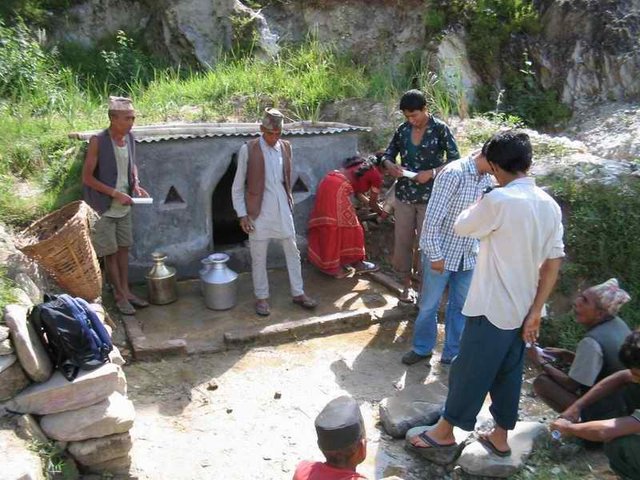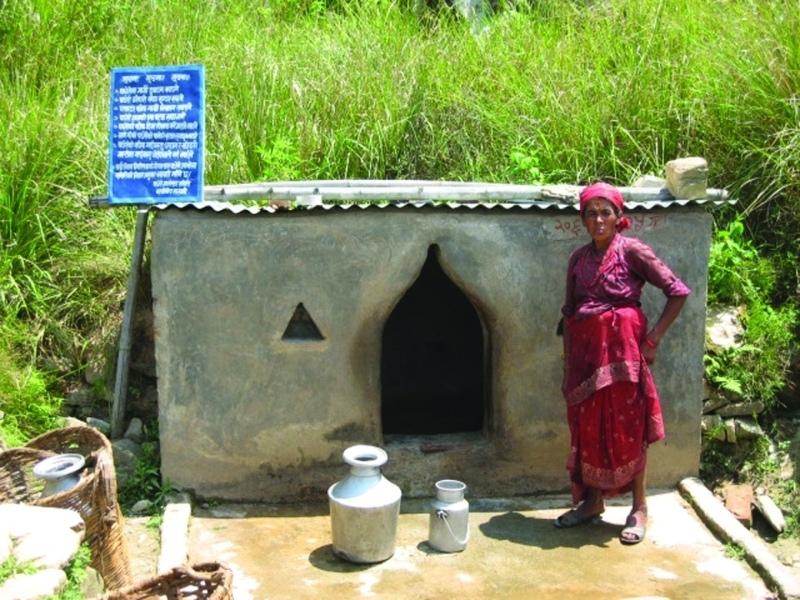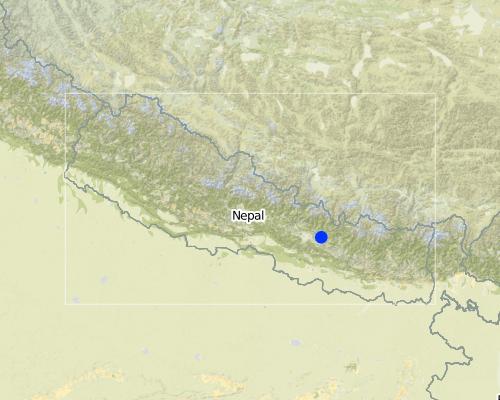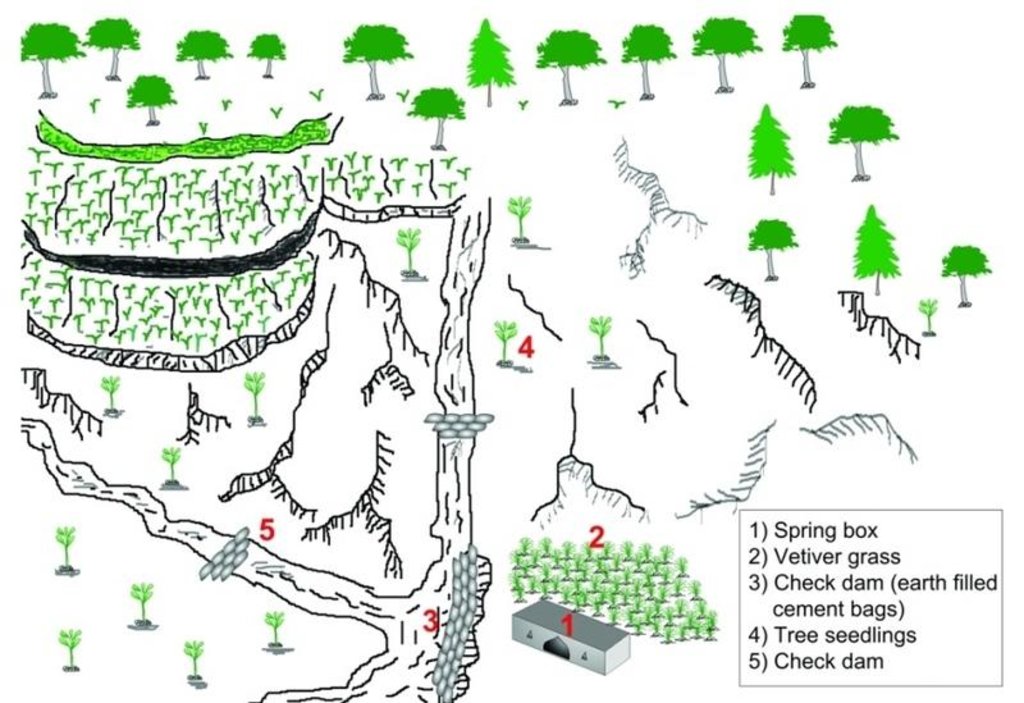Drinking water quality improvement through conservation measures [尼泊尔]
- 创建:
- 更新:
- 编制者: Madhav Dhakal
- 编辑者: –
- 审查者: David Streiff
Samrakshan bidhi dwara piune pani ko gunastar sudhar - Nepali
technologies_1496 - 尼泊尔
查看章节
全部展开 全部收起1. 一般信息
1.2 参与该技术评估和文件编制的资源人员和机构的联系方式
SLM专业人员:
SLM专业人员:
SLM专业人员:
Dongol Bhawani
bsdongol@gmail.com
尼泊尔
有助于对技术进行记录/评估的项目名称(如相关)
People and Resource Dynamics Project, Nepal (PARDYP)有助于对技术进行记录/评估的机构名称(如相关)
ICIMOD International Centre for Integrated Mountain Development (ICIMOD) - 尼泊尔1.3 关于使用通过WOCAT记录的数据的条件
(现场)数据是什么时候汇编的?:
15/09/2006
编制者和关键资源人员接受有关使用通过WOCAT记录数据的条件。:
是
1.5 请参阅有关SLM方法的问卷

Community efforts for improving drinking water quality [尼泊尔]
Working with communities to demonstrate and disseminate methods for improving drinking water quality using structural and vegetative measures
- 编制者: Madhav Dhakal
2. SLM技术的说明
2.1 技术简介
技术定义:
Structural and vegetative measures to improve the quality of drinking water contaminated due to poor sanitation and seepage
2.2 技术的详细说明
说明:
This technology combines structural and vegetative measures to improve the quality of drinking water in an open spring. The quality of water was deteriorating due to poor sanitation and seepage around the spring. The spring was located near to Dhotra village at Barbot sub-settlement, Kabhrepalanchok district. About five households depended on the spring for their drinking water supplies with a further
10 using it regularly and 10-15 using it occasionally during the dry season.
The main purpose of implementing the technology was to improve the quality of drinking water in the spring by preventing it from being contaminated by surface runoff during the rainy season. This technology has long been implemented across Nepal’s midhills. In this case a development project (PARDYP) mobilised the users and provided them with technical and material support to make the improvements.
A spring user group was formed. With project help, it built a walled structure (a spring box) over the spring and check dams around the spring, and planted grasses around the spring box and trees in the catchment. These measures prevented the direct flow of surface water into the spring thus reducing contamination and turbidity. Users built a 1.8m long, 1m wide and 1.5m high spring box with a zinc sheeted roof. Check dams were built across the surrounding gullies and rills. A main 2.5m long, 0.5m wide, and 1m high check dam was constructed near the source to prevent surface runoff from entering the spring. A drainage channel was made to drain off wastewater. Vetiver grass seedlings were planted around the spring box and trees were planted in the adjoining catchment. These activities were carried out at the beginning of the rainy season.
This technology is simple and durable and the only maintenance needed is to keep the surroundings clean and to repair any damage.
The case study area receives about 1200 mm of annual precipitation of which about 80% occurs during the monsoon season (June to September). The area mostly has red soils which are highly weathered and, if not managed properly, are very susceptible to erosive processes.
2.3 技术照片
2.5 已应用该技术的、本评估所涵盖的国家/地区/地点
国家:
尼泊尔
区域/州/省:
Kavrepalanchowk district/ Jhikhu Khola watershed
Map
×2.6 实施日期
如果不知道确切的年份,请说明大概的日期:
- 50多年前(传统)
2.7 技术介绍
详细说明该技术是如何引入的:
- 通过项目/外部干预
注释(项目类型等):
Local community, with the contribution from individual community members or from external support have been implementing since generations. In this particular case project mobilized the spring users community and assisted them by providing technical and material support during programme implementing period.
3. SLM技术的分类
3.1 该技术的主要目的
- Improve water quality
3.2 应用该技术的当前土地利用类型

牧场

其它
具体说明:
Private land-abondent by village elite, communal land-open grazing
注释:
Major land use problems (compiler’s opinion): High pressure on limited land resources due to overuse of crop, forest, and grazing lands; increased inputs of agrochemicals which will lead to the deterioration of drinking water quantity and quality
Major land use problems (land users’ perception): Water quality deterioration resulting from poor sanitation
Constraints of wastelands / deserts / glaciers / swamps: private land-abondent by village elite, communal land-open grazing
3.3 有关土地利用的更多信息
每年的生长季节数:
- 3
具体说明:
Longest growing period in days: 150; Longest growing period from month to month: Jun - Oct; Second longest growing period in days: 120; Second longest growing period from month to month: Nov - Feb
3.4 该技术所属的SLM组
- 地表水管理(泉、河、湖、海)
3.5 技术传播
具体说明该技术的分布:
- 均匀地分布在一个区域
如果该技术均匀地分布在一个区域上,请注明覆盖的大致区域。:
- < 0.1 平方千米(10 公顷)
3.6 包含该技术的可持续土地管理措施

植物措施
- V2:草和多年生草本植物

结构措施
- S5:大坝、集水斗、水池
注释:
Main measures: vegetative measures, structural measures
Type of vegetative measures: scattered / dispersed
3.7 该技术强调的主要土地退化类型

土壤水蚀
- Wo:场外劣化效应
注释:
Main causes of degradation: overgrazing (uncontrolled access to grazing land), other natural causes (avalanches, volcanic eruptions, mud flows, highly susceptible natural resources, extreme topography, etc.) specify (concentrated runoff during rainy season), education, access to knowledge and support services (lack of knowledge - water quality treatment)
Secondary causes of degradation: deforestation / removal of natural vegetation (incl. forest fires) (uncontrolled access to forest land), poverty / wealth (lack of captial - conservation activities)
3.8 防止、减少或恢复土地退化
具体数量名该技术与土地退化有关的目标:
- 减少土地退化
4. 技术规范、实施活动、投入和成本
4.1 该技术的技术图纸
4.2 技术规范/技术图纸说明
Structural and vegetative measures applied to improvewater quality of spring
Location: Barbot Dhotra. Kabhrepalanchowk district
Technical knowledge required for field staff / advisors: moderate
Technical knowledge required for land users: moderate
Main technical functions: control of concentrated runoff: impede / retard, improvement of ground cover
Secondary technical functions: increase / maintain water stored in soil
Scattered / dispersed
Vegetative material: T : trees / shrubs, G : grass
Trees/ shrubs species: Michelia champaca
Grass species: Vetiveria lawsoni
Structural measure: spring box wall
Material: concrete
Height of bunds/banks/others (m): 1.5
Width of bunds/banks/others (m): 1.02
Length of bunds/banks/others (m): 1.89
Structural measure: check dams
Height of bunds/banks/others (m): 1
Width of bunds/banks/others (m): 0.5
Length of bunds/banks/others (m): 2.5
Structural measure: cut-off drain
Material: Stone
Depth of ditches/pits/dams (m): 0.2
Width of ditches/pits/dams (m): 0.25
Length of ditches/pits/dams (m): 3
Construction material (stone): locally available
Construction material (concrete): cement, sand, brick
4.3 有关投入和成本计算的一般信息
具体说明成本和投入是如何计算的:
- 每个技术单元
指定单位:
Spring box and plants
指定体积、长度等(如果相关):
1.8m long, 1m wide and 1.5m high with a zinc sheeted roof
具体说明成本计算所用货币:
- 美元
注明雇用劳工的每日平均工资成本:
1.60
4.4 技术建立活动
| 活动 | 措施类型 | 时间 | |
|---|---|---|---|
| 1. | Planting vetiver grass around the spring box | 植物性的 | beginning of rainy season |
| 2. | Planting tree species in the catchment | 植物性的 | beginning of rainy season |
| 3. | Building of check dams to divert stream and gully runoff water | 结构性的 | start of the rainy season |
| 4. | Buildingof the spring box | 结构性的 | start of the rainy season |
| 5. | Construction of concrete floor in front of spring box | 结构性的 | start of the rainy season |
| 6. | Construction of drainage channel | 结构性的 | start of the rainy season |
4.5 技术建立所需要的费用和投入
| 对投入进行具体说明 | 单位 | 数量 | 单位成本 | 每项投入的总成本 | 土地使用者承担的成本% | |
|---|---|---|---|---|---|---|
| 劳动力 | Building spring box and planting trees | Persons/day | 69.0 | 1.6 | 110.4 | 80.0 |
| 植物材料 | Grass seedlings | unit | 1.0 | 4.0 | 4.0 | |
| 施工材料 | Cement | unit | 1.0 | 44.0 | 44.0 | |
| 施工材料 | Gravel / sand | unit | 1.0 | 55.0 | 55.0 | 100.0 |
| 施工材料 | Bricks | unit | 1.0 | 188.0 | 188.0 | |
| 施工材料 | Empty sacks | unit | 1.0 | 5.0 | 5.0 | |
| 施工材料 | Tinc sheet | unit | 1.0 | 16.0 | 16.0 | |
| 施工材料 | Steel wire | unit | 1.0 | 1.0 | 1.0 | |
| 施工材料 | Transportation | unit | 1.0 | 10.0 | 10.0 | 15.0 |
| 技术建立所需总成本 | 433.4 | |||||
如果土地使用者负担的费用少于100%,请注明由谁负担其余费用:
PARDYP and District Development Committee
注释:
Duration of establishment phase: 12 month(s)
4.6 维护/经常性活动
| 活动 | 措施类型 | 时间/频率 | |
|---|---|---|---|
| 1. | replacement/ gap filling with new tree seedings | 植物性的 | /as required |
| 2. | maintaining height of the planted grass | 植物性的 | /as required |
| 3. | Cleaning spring box surroundings | 结构性的 | as per need |
| 4. | Maintenance of wall/ floor against damage | 结构性的 | as per need |
| 5. | Maintenance of check dam against damage | 结构性的 | as per need |
4.7 维护/经常性活动所需要的费用和投入(每年)
| 对投入进行具体说明 | 单位 | 数量 | 单位成本 | 每项投入的总成本 | 土地使用者承担的成本% | |
|---|---|---|---|---|---|---|
| 劳动力 | Maintaining springbox | Persons/day | 2.0 | 1.6 | 3.2 | 100.0 |
| 技术维护所需总成本 | 3.2 | |||||
注释:
Machinery/ tools: hoe,spade, shovel, nails, hammer, pliers, trowel, steel pan bucket, and jug
The cost is only for unit technology, it can not be extrapolated to hector basis, as in 2006.
4.8 影响成本的最重要因素
描述影响成本的最决定性因素:
Material cost was comparatively high followed by labor cost. For this technology several actors contributed. The land users contributed 61 percent, District Development Committee contributed 26 percent and PARDYP contributed 13 percent, and the department of forest and PARDYP regional coordinator contributed by providing planting materials( vetiver).
5. 自然和人文环境
5.1 气候
年降雨量
- < 250毫米
- 251-500毫米
- 501-750毫米
- 751-1,000毫米
- 1,001-1,500毫米
- 1,501-2,000毫米
- 2,001-3,000毫米
- 3,001-4,000毫米
- > 4,000毫米
指定年平均降雨量(若已知),单位为mm:
1200.00
农业气候带
- 潮湿的
Thermal climate class: subtropics
5.2 地形
平均坡度:
- 水平(0-2%)
- 缓降(3-5%)
- 平缓(6-10%)
- 滚坡(11-15%)
- 崎岖(16-30%)
- 陡峭(31-60%)
- 非常陡峭(>60%)
地形:
- 高原/平原
- 山脊
- 山坡
- 山地斜坡
- 麓坡
- 谷底
垂直分布带:
- 0-100 m a.s.l.
- 101-500 m a.s.l.
- 501-1,000 m a.s.l.
- 1,001-1,500 m a.s.l.
- 1,501-2,000 m a.s.l.
- 2,001-2,500 m a.s.l.
- 2,501-3,000 m a.s.l.
- 3,001-4,000 m a.s.l.
- > 4,000 m a.s.l.
关于地形的注释和进一步规范:
Altitudinal zone: 900 m a.s.l.
5.3 土壤
平均土层深度:
- 非常浅(0-20厘米)
- 浅(21-50厘米)
- 中等深度(51-80厘米)
- 深(81-120厘米)
- 非常深(> 120厘米)
土壤质地(表土):
- 细粒/重质(粘土)
表土有机质:
- 低(<1%)
如有可能,附上完整的土壤描述或具体说明可用的信息,例如土壤类型、土壤酸碱度、阳离子交换能力、氮、盐度等。:
Soil depth on average: Variable
Soil texture: Red soils with high clay content
Soil fertility is very low
Soil drainage / infiltration is medium
Soil water storage capacity is very low
5.4 水资源可用性和质量
地表水的可用性:
匮乏/没有
水质(未处理):
不良饮用水(需要处理)
关于水质和水量的注释和进一步规范:
Water quality (untreated): More contamination during monsoon season (June- September), source: mainly natural springs
5.6 应用该技术的土地使用者的特征
非农收入:
- 收入的10-50%
相对财富水平:
- 贫瘠
- 平均水平
个人或集体:
- 团体/社区
性别:
- 女人
- 男人
说明土地使用者的其他有关特征:
Land users applying the Technology are mainly common / average land users
Population density: 200-500 persons/km2
Annual population growth: 2% - 3%
15% of the land users are average wealthy and own 35% of the land.
85% of the land users are poor and own 65% of the land.
Off-farm income specification: In most farm households, off-farm income plays at least a minor and increasingly a major role. Occasional opportunities for off-farm income present themselves in the form of daily
labour wages. Some households’ members receive regular salaries, whilst an increasing number of Nepalis are
working in India, the Middle East, Malaysia, and elsewhere and sending remittance incomes home.
5.7 应用该技术的土地使用者拥有或租用的平均土地面积
- < 0.5 公顷
- 0.5-1 公顷
- 1-2 公顷
- 2-5公顷
- 5-15公顷
- 15-50公顷
- 50-100公顷
- 100-500公顷
- 500-1,000公顷
- 1,000-10,000公顷
- > 10,000公顷
这被认为是小规模、中规模还是大规模的(参照当地实际情况)?:
- 小规模的
5.8 土地所有权、土地使用权和水使用权
土地所有权:
- 州
- 个人,有命名
土地使用权:
- 社区(有组织)
用水权:
- 自由进入(无组织)
6. 影响和结论性说明
6.1 该技术的现场影响
社会经济效应
收入和成本
工作量
注释/具体说明:
decreased women's workload for collecting water, since water is available near to the households
社会文化影响
健康状况
注释/具体说明:
water quality improvement
社区机构
注释/具体说明:
formation of user group; less conflicts for drinking water
SLM/土地退化知识
注释/具体说明:
group discussion, awareness
冲突缓解
注释/具体说明:
conflicts due to insufficient water quantity. Especially during dry and pre- monsoon months
livelihood and human well-being
注释/具体说明:
Better health due to clean water.
生态影响
水循环/径流
多余水的排放
注释/具体说明:
due to drainage trench and check dams
土壤
土壤覆盖层
注释/具体说明:
due to planted grasses and trees
土壤流失
注释/具体说明:
due to check dams
6.3 技术对渐变气候以及与气候相关的极端情况/灾害的暴露和敏感性(土地使用者认为的极端情况/灾害)
渐变气候
渐变气候
| 季节 | 气候变化/极端天气的类型 | 该技术是如何应对的? | |
|---|---|---|---|
| 年温度 | 增加 | 好 |
气候有关的极端情况(灾害)
气象灾害
| 该技术是如何应对的? | |
|---|---|
| 局地暴雨 | 不好 |
| 局地风暴 | 好 |
气候灾害
| 该技术是如何应对的? | |
|---|---|
| 干旱 | 不好 |
水文灾害
| 该技术是如何应对的? | |
|---|---|
| 比较和缓的(河道)洪水 | 不好 |
其他气候相关的后果
其他气候相关的后果
| 该技术是如何应对的? | |
|---|---|
| 缩短生长期 | 好 |
6.4 成本效益分析
技术收益与技术建立成本相比如何(从土地使用者的角度看)?
短期回报:
积极
长期回报:
非常积极
技术收益与技术维护成本/经常性成本相比如何(从土地使用者的角度看)?
短期回报:
非常积极
长期回报:
非常积极
注释:
Clean water is available immediately after only a little investment. Government and PARDYP support meant that the short-term benefit was positive. Without this support the short-term costs would equal the benefi ts.
6.5 技术采用
- 大于 50%
如若可行,进行量化(住户数量和/或覆盖面积):
15 households in an area of 10 ha
在所有采用这项技术的人当中,有多少人是自发地采用该技术,即未获得任何物质奖励/付款?:
- 0-10%
注释:
100% of land user families have adopted the Technology with external material support
15 land user families have adopted the Technology with external material support
Comments on acceptance with external material support: survey results
There is a moderate trend towards spontaneous adoption of the Technology
Comments on adoption trend: Local people with inadequate access to drinking water or whose source is contaminated are
likely to adopt the technology after raising the funds themselves.
6.7 该技术的优点/长处/机会
| 土地使用者眼中的长处/优势/机会 |
|---|
|
Increased availability of drinking water has reduced women’s workload during the dry season. How can they be sustained / enhanced? Improve the technology by building a closed storage tank. |
| 编制者或其他关键资源人员认为的长处/优势/机会 |
|---|
|
Water turbidity decreased from 23 nephelometric turbidity units (NTU) in August 2004 to 7 NTU in August 2005. How can they be sustained / enhanced? Encourage spring users to plant more multiple grasses and tree species around the catchment area |
|
Faecal contamination decreased from 500 coliform formation units (CFU)/100 ml in August 2004 to 200 CFU/100 ml in August 2005. Similarly, the levels of ammonia (NH3) and nitrate (NO3 in the spring water have decreased (NH3 from 0.5 to 0 mg/l; and NO3 from 0.7 to 0.5 mg/l). Total hardness of spring water remained the same at 30 mg/l. How can they be sustained / enhanced? Regular maintenance, especially cleaning the surrounding area is needed; also need a clean pot for extracting the water. |
6.8 技术的弱点/缺点/风险及其克服方法
| 编制者或其他关键资源人员认为的弱点/缺点/风险 | 如何克服它们? |
|---|---|
| Coliform bacteria are still a problem | Treat the water using SODIS, boiling, fi lters, chlorination or other methods before drinking. |
| The water available during the pre-monsoon season is insufficient for the15 households, leading to conflicts; the water source can be contaminated from unclean water fetching pots. |
The water in the spring box should be siphoned into a storage tank fi tted with an overfl ow mechanism,cleaning outlet, lockable cover, and taps. This would protect the water source from contamination from open access and improve the quality and availability of water. The amount available could be increased by tapping other spring sources. |
7. 参考和链接
7.2 参考可用出版物
标题、作者、年份、ISBN:
ICIMOD (2007) Good Practices in Watershed Management: Lessons Learned in the Mid Hills of Nepal. Kathmandu: ICIMOD
可以从哪里获得?成本如何?
ICIMOD
链接和模块
全部展开 全部收起链接

Community efforts for improving drinking water quality [尼泊尔]
Working with communities to demonstrate and disseminate methods for improving drinking water quality using structural and vegetative measures
- 编制者: Madhav Dhakal
模块
无模块





